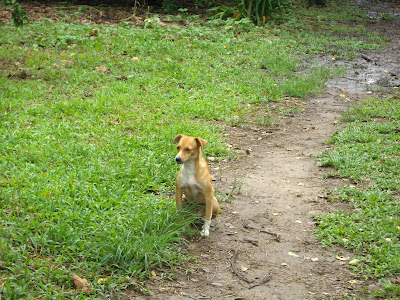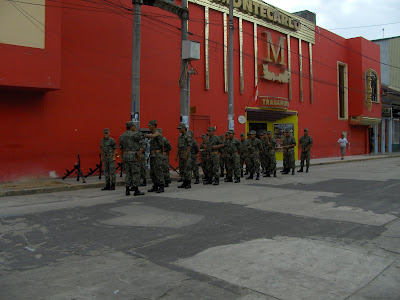The path is fraught with nothing but sanculos... the pests are so abundant that the locals even refer to the bugs by their English name: mosquitoes.
The end of the path was submerged in water.
This is where the rainboots come in handy! We forded a few feet of water and came to a sort of meeting house where people were castrating a pig. Poor guy... but we didn't stay long. Once Artemio procured two oars, we were off on another boat!
Okay, so this boat wasn't quite community property but the oars (and later, the motor) still were.
The next three photos show some trees with dark and light portions of the trunks. It turns out that during the rainy season, the rivers can rise a good two meters (hence the houses on stilts.) The dark portion of the trunks are the parts that get submerged when it floods. And in order to get marks that distinct, the river probably floods to the same height almost every year. When it comes to regularity, Jamie Lee Curtis and her Activia yogurt has nothing on these Amazon rivers!
The river winds down into another world for miles but we didn't have to travel far today...
Meet the Yahua, a friendly Amazonian tribe that shoots blowdarts and understands tourism very well. Do you see that little girl in front? She shamelessly pointed to my earrings (later another guest told me that she wanted me to give them to her) and asked for tips when I took a photo of my friend on the village grounds. Authentic, I suppose, but not the sort most people desire.
Still, visiting this tribe was pretty cool. The chief is the little man on the right. He speaks some Spanish and welcomed us to try our hands (or mouths) at blowdarts.
First the chief showed us how it was done...
... and easily landed two darts on the target.
My first two tries didn't go very far. But once I understood that a huge blowdart gun needs some huge wind, I blew quite forcefully and got my dart closer to the nose than the chief's!
So cool! But don't be fooled by the beautiful miniature blowdarts for sale as they are for decoration only. I have two such souvenirs sitting on a table of curios and I will always laugh at myself for thinking that the Yahua would sell real weapons to outsiders.
Anyways, motherly Pame was smitten with the baby...
She loved talking up the mother of the newborn, who in her early twenties is just one of the three wives of the chief. Here she is with her baby boy and hard-working young daughter.
The Yahua don't really live in the settlement we visited... not only is it not very private at all, it is too close and low to the water and would wash away with each flood. Instead, they live further into the jungle and find it easier to meet tourists halfway at the bank.
Ever eager to share, Pedro pointed out the fruits in the nearby trees...
These soft spiny pieces are not for eating; instead, the seeds inside are crushed to make the vibrant red pigment with which the Yahua men paint their faces. This plant also comes in yellow and green varieties and, as expected, produces yellow and green facepaint.
Since the Yahua's "business location" was so small, there wasn't too much to do after blowing darts and blowing money on knick-knacks. So we headed back to the lodge for lunch and more adventures.
On our way back to the lodge, we met the people of San Juan de H. at the point where the jungle trail sinks down into the river. They had gathered for a boat-launching party and it looked as though all the able-bodied young people had assembled to push the boat in. All fifteen of them.





















































